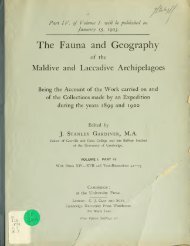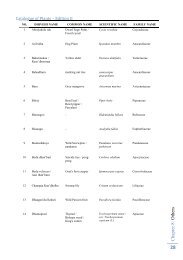Download - WordPress – www.wordpress.com
Download - WordPress – www.wordpress.com
Download - WordPress – www.wordpress.com
Create successful ePaper yourself
Turn your PDF publications into a flip-book with our unique Google optimized e-Paper software.
THE ENTEROPNEUSTA. 653Trunk. The branchial region in this variety is very short, averaging only a quarteras much again as the collar length (see Table 12, p. 673). In the Maldive specimensthe branchial part of the oesophagus is at least as large and generally somewhat largerthan the ventral portion. In the Minikoi specimens on the other hand it is somewhatsmaller, a feature in which they appro.xiniate to laccadivensis. The post-branchial gi-oove isvery short in the specimens from Hulule, not being more than about -jL of the length ofthe short branchial region. In the Minikoi specimens it is rather longer. The genitalpleurae are large in the branchial region (PI. XLVI. figs. 50, 54). They diminish in sizeconsiderably in the region of the post-branchial groove (PI. XLVI. figs. 53, 55), after whichthey arevery small.The proportions of the various regions of the body in the above account have beendetermined from an examination of 28 specimens from Hulule (vide Table 12, p. 673).Five specimens only were procured from Minikoi and, as will be seen in Table 4, Nos. 4and 5, these differ somewhat from the Hulule forms. It is possible that e.xamination of alarger amount of material may shew that these Minikoi specimens belong to a distinct variety.The difference in their mode of occurrence (p. 651) would seem to point the same way,but in any case they are verj' closely related to the Hulule form.Ptychodera flava, var. muscula (PL XLII. fig. 18).Locality, etc. A Maldive form from Goifurfehendu Atoll, Goidu. It was obtained fromthe sandy shore to the east of the island in the sand below the weed and under somesquare slabs of beach sandstone. In <strong>com</strong>pany with it was found Spengelia porosa. Abouta dozen specimens procured inall.External features. Colour in life pale yellow with very black hepatic region. Asmall form with a total length after preservation of 31— 48 mm. Average length <strong>com</strong>paredwith collar as unity = 15'6. A somewhat short and stoutly built fonn, generally speaking.The anterior hepatic caeca are, after preservation, darker than the rest.Internal stbuctxjre.Proboscis. The internal longitudinal musculature is very strongly developed and closelysurrounds the central <strong>com</strong>plex, almost obliterating the proboscis cavity. No dorso-ventralmuscles anterior to the pericardium. The ventral proboscis septum is short and does notreach nearly to the tip of the stomochord. Of the paired proboscis pores one may notbe functional. The racemose organ may be small or fairly well marked and slightly lobulated.The nuchal skeleton has a well-developed keel which gives off a flattened expansion overthe racemose organ. Such an expansion occurs generally in the genus but is not usuallj^so well-marked as in the present variety (PI. XLII. fig. 18). A strong dorsal musculardecussation occurs in the anterior portion of the proboscis, and from it pass some circularfibresventrally.Collar. The musculature of this region also is swell developed. The cavity in theanterior part of the proboscis is <strong>com</strong>paratively large. The dorsal septum is found as usualafter the firet root though it may not immediately be <strong>com</strong>plete. The ventral septum isabsent or traces of it only are to be found.The lumen of the nerve cord shews a marked tendency to be<strong>com</strong>e occluded. Three orfour dorsal roots may be present.G. II. 84






